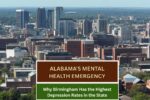Rhode Island, the smallest state in the U.S., has one of the nation’s highest reported rates of depression. Recent data released by the Centers for Disease Control and Prevention (CDC) reveals important insights into mental health trends, especially within certain counties and cities that are struggling more than others.
Washington County: The Highest Reported Depression Rate in Rhode Island
According to the CDC’s 2023 Behavioral Risk Factor Surveillance System (BRFSS), Washington County holds the unfortunate distinction of having the highest depression rate in the state. Approximately 24.4% of adults in Washington County have been diagnosed with depression at some point in their lives. This number is well above the state average of 21.1% and even slightly higher than the national average of 21%.
These findings suggest that nearly one in four adults in this area are grappling with a diagnosed depressive disorder. The data does not explore the exact causes, but rural isolation, economic stressors, and limited access to mental healthcare in certain parts of the county may be contributing factors.
Providence: High Depression Rates and Low Wellbeing Scores
Although Washington County leads in clinical diagnoses, Providence, Rhode Island’s capital and most populous city, also shows significant signs of mental health distress.
In a 2023 study by The Zebra, Providence was ranked among the most depressed major cities in America, with a Wellbeing Index score of 59.6 out of 100—a score lower than many other U.S. urban centers. The city also showed that 7.69% of adults reported experiencing a major depressive episode within the past year.
While this number is smaller than Washington County’s lifetime diagnosis rate, it reflects active and recent emotional struggles, particularly among urban populations.
Factors like poverty, housing insecurity, and socioeconomic disparities likely play a significant role. Providence’s diverse but economically divided population faces unique stressors that affect community health outcomes.
Why Are These Rates So High in Rhode Island?
Several factors contribute to Rhode Island’s high depression rates:
- Economic Challenges: Parts of the state still struggle with underemployment, income inequality, and rising living costs.
- Access to Care: While Rhode Island has a relatively high number of healthcare providers per capita, access is not evenly distributed. Mental health services may be scarce in rural areas like parts of Washington County.
- Social Isolation: Especially in post-pandemic years, both urban and rural communities have reported increased levels of social withdrawal and loneliness.
- Stigma Around Mental Health: Despite ongoing efforts, stigma continues to prevent many individuals from seeking help early.
State Response and Resources
Rhode Island has acknowledged its mental health crisis and is working on expanding access to mental health services. The Rhode Island Department of Health provides a range of resources, including links to local treatment providers, crisis services, and information on how to get help.
For urgent mental health assistance, the BH Link offers 24/7 support via phone and walk-in locations. The center aims to connect individuals in crisis with appropriate services as quickly as possible.
National resources such as the Substance Abuse and Mental Health Services Administration (SAMHSA) also provide locator tools and information about free and low-cost treatment options.
What Can Be Done?
Public health officials and local leaders are working to improve mental health outcomes through a variety of approaches:
- Expanding Telehealth Services: Remote access to therapists and psychiatrists has helped bridge gaps in care, especially in underserved communities.
- Community Programs: Outreach through schools, churches, and nonprofits is vital to raising awareness and reducing stigma.
- Policy Measures: Continued investment in housing, employment, and substance abuse treatment is essential to improving overall wellbeing.
Conclusion
While both Washington County and Providence face serious mental health challenges, they represent broader issues affecting communities across Rhode Island. The state’s above-average depression rates highlight the need for sustained public health attention, better access to care, and deeper community support systems.
This article has been carefully fact-checked by our editorial team to ensure accuracy and eliminate any misleading information. We are committed to maintaining the highest standards of integrity in our content.

Outside of work, he enjoys playing chess, following cricket, and writing short stories. His commitment to integrity and in-depth analysis strengthens OTE News’ mission of providing trustworthy journalism.




